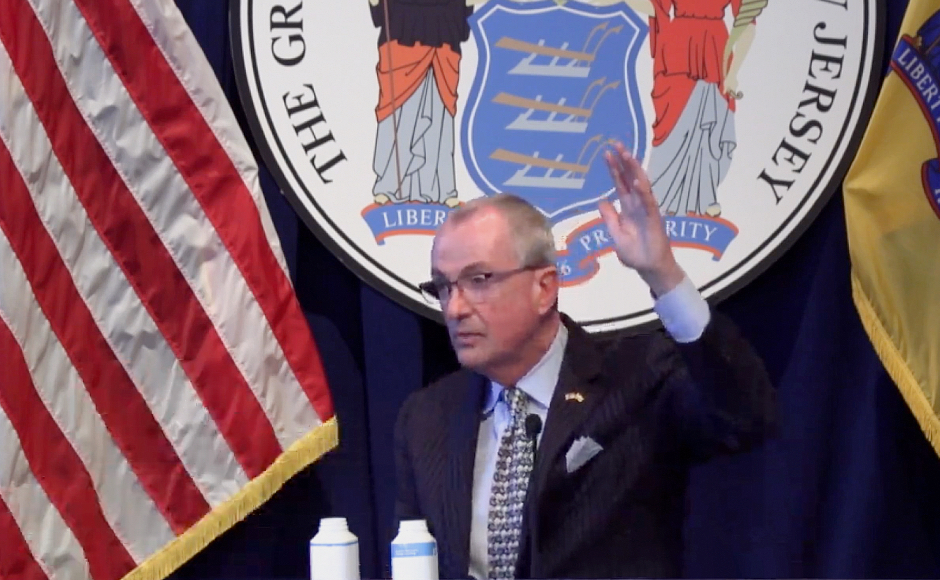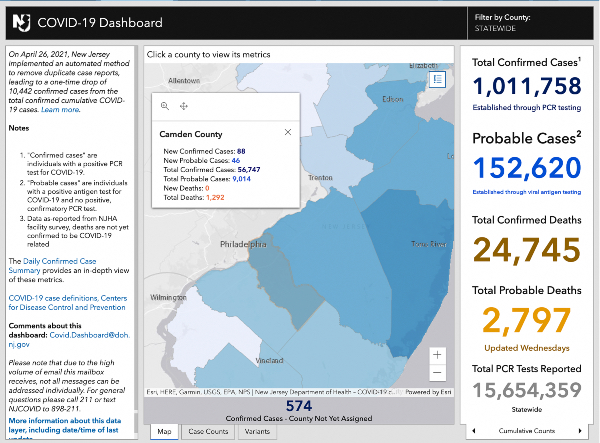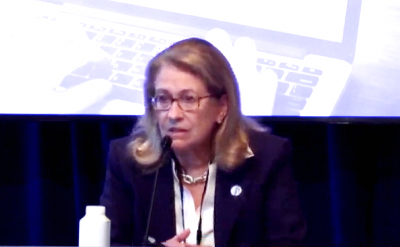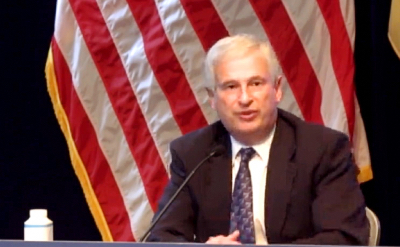Plus: predictive modeling from health experts forecasts a COVID uptick around holidays but officials say present data trends are ‘reassuring.’
By Matt Skoufalos | October 6, 2021
Another 1,512 New Jersey residents have tested positive for novel coronavirus (COVID-19), bringing the statewide total to 1.011 million cases confirmed via polymerase chain reaction (PCR) testing, Governor Phil Murphy reported Wednesday.
New Jersey is also reporting 451 new COVID-probable cases based on antigen tests, bringing the statewide total to 152,620 positive antigen tests.
Antigen tests have a faster turnaround time than PCR tests—sometime within 15 to 30 minutes—but are less reliable at detecting active infection of the virus, and more capable of reporting false positives.
Sadly, 20 more residents have perished from complications related to the virus, bringing the statewide, confirmed death toll to 24,745 lives lost during the pandemic.
In addition to those lab-confirmed fatalities, the state has acknowledged another 2,797 probable COVID-19-related deaths.
Since March 2020, 1,050 of every 100,000 New Jersey residents have been hospitalized with COVID-19, and 281 of every 100,000 have died from COVID-19-related complications.
More than 15.626 million polymerase chain reaction (PCR) tests for COVID-19 have been performed statewide, with a 11.491-percent positivity rate per 100,000 residents.
Rate of transmission (Rt) continues to fall, spot positivity highest in South Jersey
The statewide average of COVID-19 spot positivity testing based on PCR test results stood at 5.19 percent October 9; in South Jersey, it was highest, at 5.63 percent.
Rt, the variable that describes the seven-day, rolling-average, statewide rate of transmission of new COVID-19 cases, fell again, to 0.88, on October 6.
Any Rt figure less than 1.0 means that each new COVID-19 patient is infecting fewer than one other person, on average, and the spread of the virus is decreasing.
Since its mid-April-2020 COVID-19 spike, the highest reported RT in New Jersey was 1.48, recorded August 1, 2020. Prior to artificially low, adjusted reports of 0.34 in the first week of May, the lowest in the past year was 0.62, recorded June 9, 2020. On May 21, 2021, it reached a new low, of 0.59.
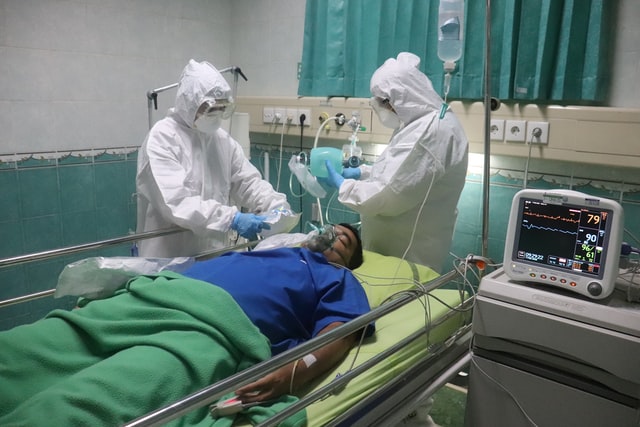
Simulated COVID-19 patient in a hospital bed. Photo by Mufid Majnun on Unsplash
Hospitalizations, ICUs, ventilator use all trending down
Throughout New Jersey, 1,034 people currently are hospitalized with a suspected (57) or confirmed (977) case of COVID-19, Murphy said.
Among those hospitalized patients, 242 are in intensive or critical care, and 130 of the ICU and critical-care patients (54 percent) are on ventilators.
In New Jersey’s 71 critical care hospitals, 116 patients were hospitalized with COVID-19 yesterday, while 144 others were discharged.
Throughout the past two weeks, New Jersey has seen improvements among its numbers of newly hospitalized people (down 16 percent), those in ICU beds (down 8 percent), and ventilator usage (down 6 percent), New Jersey Health Commissioner Judy Persichilli said Wednesday. Overall, the statewide hospital census is down 7 percent, an encouraging trend.
LTC update
Across the state, long-term care (LTC) centers have reported 1,734 cumulative outbreaks of COVID-19, and 158 are dealing with an active outbreak. LTCs account for 56,764 infected patients and staff in New Jersey, or 5.7 percent of total cases.
That includes 33,716 residents and 23,048 staffers sickened by the virus, as well as 8,558 lab-confirmed resident and staff deaths (35 percent of the statewide confirmed total), with facilities self-reporting 145 staff deaths.
Of 650 veterans residing in three state-run homes, 456 residents have tested positive for COVID-19, and 157 have died from complications related to the virus. Three hundred veterans have recovered from the virus. No resident currently is COVID-19-positive.
The facilities at Menlo Park, Paramus, and Vineland are staffed by 1,370 workers, two of whom are presently COVID-19-positive. The facilities have sustained two staff deaths related to the virus.
At state-run psychiatric hospitals, 374 of 1,139 patients and 1,136 staff members have tested positive for COVID-19. Fourteen patients and eight staffers have died from complications related to the virus.
MISC cases and schools
To date, 133 New Jersey children aged 1 to 18 have been diagnosed with pediatric multisystem inflammatory syndrome (MISC). Four of those cases were reported in Camden County, tied with Cumberland and Monmouth Counties for third-least in the state.
All those pediatric patients have tested positive for an active COVID-19 infection or the presence of COVID-19 antibodies, indicating exposure to the virus. No deaths have been associated with this syndrome in New Jersey, although several children have been hospitalized during their treatment for the illness.
From August 1, 2020 through the end of the 2020-2021 school year, 293 COVID-19 outbreaks encompassing 1,385 individual cases were traced to schools in all 21 New Jersey counties. In Camden County, 18 outbreaks were linked to 78 in-school cases, sixth-most in the state.
Since the start of the 2021-2022 school year, 69 reported outbreaks—three or more students or staff who contracted the virus within the school—have been logged across 62 school districts, affecting 319 students and 60 staff.
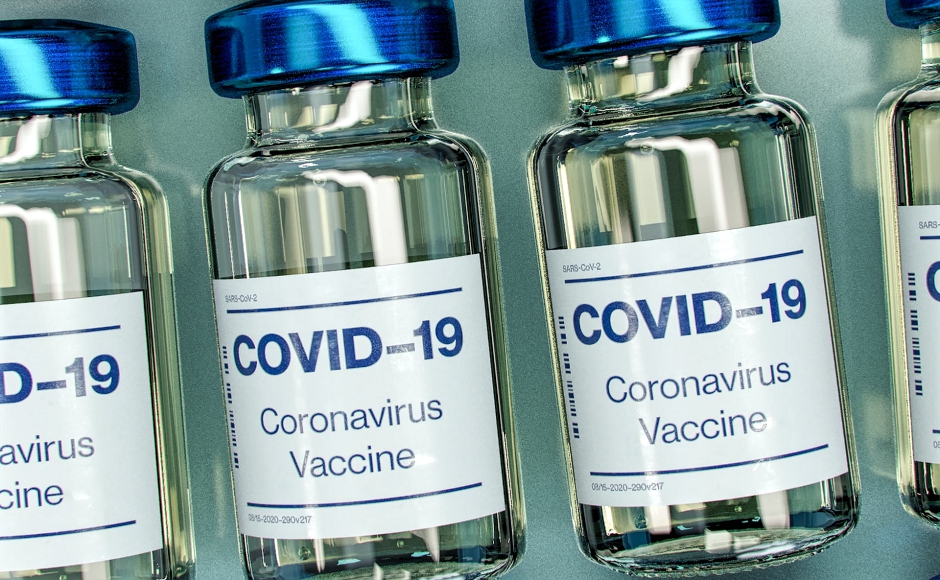
COVID-19 vaccine bottle mock-up. Photo by Daniel Schludi on Unsplash
Vaccination update: NJ approaches 6M fully vaccinated people, exceeds 11M doses administered
Across New Jersey, 11.822 million COVID-19 inoculations have been administered.
Throughout New Jersey, 5.708 million people have been fully vaccinated in-state, having received either a one-shot formulation from Johnson and Johnson or both doses of the two-shot Pfizer or Moderna vaccines.
In Camden County, 630,291 doses have been administered, seventh-most in the state; 349,173 people have been fully vaccinated.
An estimated 438,677 vaccine doses have been administered to New Jersey residents outside of the state, of which 188,660 residents are estimated to have been fully vaccinated.
The first vaccines in the state were administered December 15, 2020; by February 8—55 days later—New Jersey had immunized its millionth resident. Twenty days thereafter, that count hit 2 million, and 3 million within two more weeks.
On March 29, New Jersey crossed the 4-million-dose threshold, and the state cleared 5 million doses over the weekend of April 10, 2021. Eight days after that, New Jersey hit the 6-million-dose mark. By May 3, 2021, the state had cleared 7 million doses administered, and two weeks later, it had surpassed 8 million doses.
As of June 2, 2021, the state had cleared 9 million administered doses and 4 million fully vaccinated New Jerseyans, and on June 18, hit 4.7 million vaccinated individuals, its target goal for 70 percent of the adult population of the state.
By mid-July, that number had increased to 5.019 people fully vaccinated at New Jersey vaccination sites. By the end of August 2021, the state had exceeded 11 million doses administered and had begun approaching 6 million fully vaccinated residents.
NJDOH mandates weekly COVID reporting data from schools
Starting October 26, all school districts in New Jersey will be required to report COVID-19 testing data to the state Department of Health.
New Jersey Health Commissioner Judy Persichilli said the reporting data will include testing results, testing vendor information, and cases reported to the district from parents, students, and staff.
These reports must also be made to local health authorities, and aggregate data should be reported to staff and students as well, Persichilli said.
To date, the health commissioner reported that 758 New Jersey public school districts and non-public schools (552 local agencies and 206 non-public schools) representing “a little over 1.4 million students and staff” already partner with the Department of Health for their in-school testing programs.
As schools implement testing plans, Persichilli said the data “will provide insight on the circulation of the virus among schoolchildren and staff,” but is not wholly indicative of school-related outbreak data.
Federal report on vaccine efficacy: 10-percent vax increase lowers hospitalizations, deaths 11 to 12 percent among seniors
Persichilli also unpacked a new report from the federal Department of Health and Human Services that describes how COVID-19 vaccinations were linked to approximately 265,000 fewer COVID-19 infections, 107,000 fewer hospitalizations, and the prevention of 39,000 deaths among Medicare beneficiaries between January and May 2021.
In that time period, “the study found an 11-12 percent decrease in weekly COVID-19 hospitalizations and deaths among Medicare beneficiaries for every 10 percent increase in county vaccination rates,” HHS reported.
The study was conducted within the HHS Office of the Assistant Secretary for Planning and Evaluation (ASPE).
Predictive models forecast holiday spike in cases, hospitals should be able to hold
Finally, Persichilli and Dr. Ed Lifshitz, head of the New Jersey Communicable Disease Service, said Wednesday that they expect an uptick in new COVID-19 cases by year’s end as people gather indoors for winter holidays.
However, overall improvements in pandemic data in the past two weeks have led to a sunnier outlook among predictive models for the path of the pandemic in New Jersey, Persichilli said.
“Every two weeks we look at our assumptions around predictive modeling,” she said. “The predictive modeling we’ve just done is far different than it was even three weeks ago.
“We expect an uptick between Thanksgiving and Christmas, within a range that the capacity can be handled very well by our hospitals,” Persichilli said.
Those assumptions are based on “vaccine recommendations and impact, current hospitalizations and their impacts on cases,” and ICU and ventilator usage, she said.
Lifshitz added that the models also include demographic trends over time, which led him to conclude that the “school numbers are looking good here.”
“Overall, the trends are certainly reassuring,” Lifshitz said. “We’re not seeing an increase among college-aged people, who are more vaccinated among their age group than school-aged kids. Overall, patterns are positive.”

